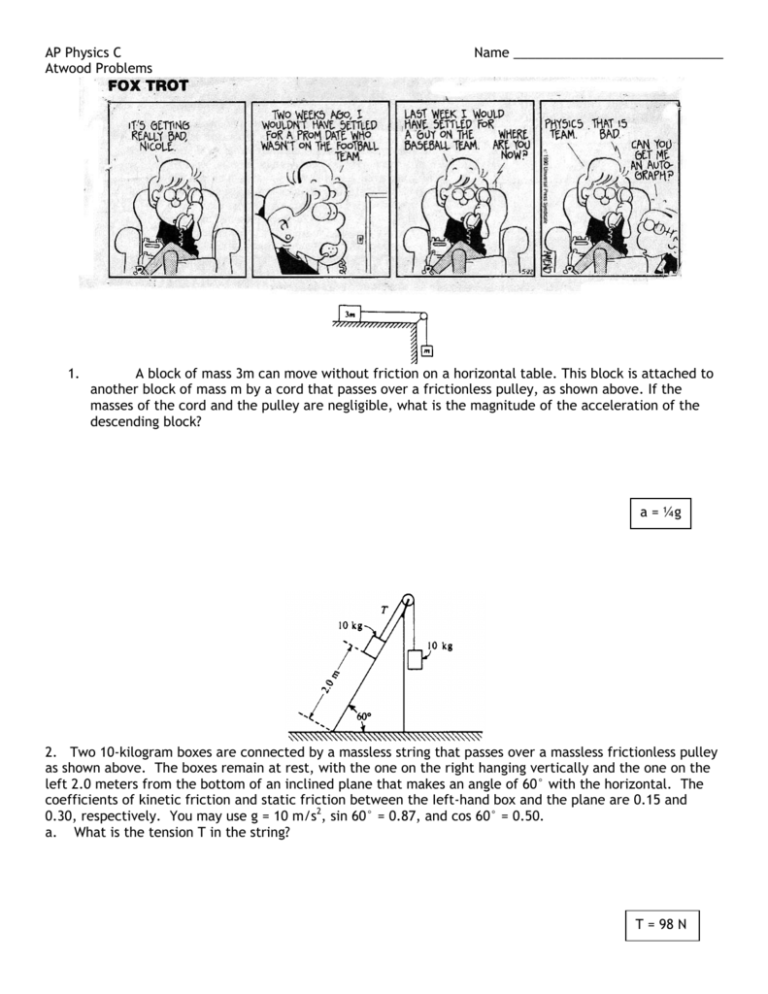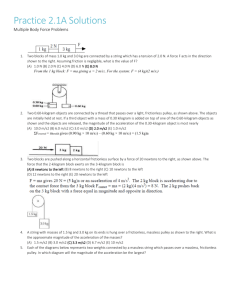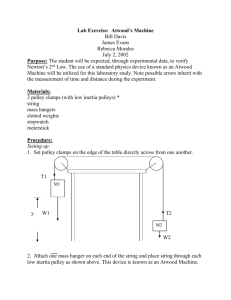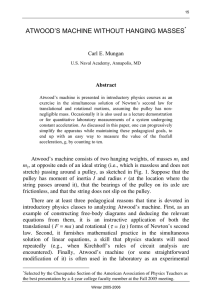AP Physics C
advertisement

AP Physics C Atwood Problems 1. Name _____________________________ A block of mass 3m can move without friction on a horizontal table. This block is attached to another block of mass m by a cord that passes over a frictionless pulley, as shown above. If the masses of the cord and the pulley are negligible, what is the magnitude of the acceleration of the descending block? a = ¼g 2. Two 10-kilogram boxes are connected by a massless string that passes over a massless frictionless pulley as shown above. The boxes remain at rest, with the one on the right hanging vertically and the one on the left 2.0 meters from the bottom of an inclined plane that makes an angle of 60° with the horizontal. The coefficients of kinetic friction and static friction between the Ieft-hand box and the plane are 0.15 and 0.30, respectively. You may use g = 10 m/s2, sin 60° = 0.87, and cos 60° = 0.50. a. What is the tension T in the string? T = 98 N AP Physics C Name _____________________________ Atwood Problems b. On the diagram below, draw and label all the forces acting on the box that is on the plane. c. Determine the magnitude of the frictional force acting on the box on the plane. f = 13.1 N The string is then cut and the left-hand box slides down the inclined plane. d. What is the acceleration of the block down the ramp? a = 7.75 m/s2 e. How much time does it take for the block to reach the base of the incline? t = 0.72 s f. Assuming the hanging mass is 2.0 m above the ground, how much time does it take for the hanging mass to hit the ground? t = 0.64 s AP Physics C Atwood Problems Name _____________________________ 3. Three blocks of masses 1.0, 2.0, and 4.0 kilograms are connected by massless strings, one of which passes over a frictionless pulley of negligible mass, as shown above. Calculate each of the following. a. The acceleration of the 4-kilogram block a = 1.4 m/s2 b. The tension in the string supporting the 4-kilogram block T = 33.6 N c. The tension in the string connected to the l-kilogram block T = 11.2 N AP Physics C Atwood Problems Name _____________________________ 1998M3. Block 1 of mass m1 is placed on block 2 of mass m2 which is then placed on a table. A string connecting block 2 to a hanging mass M passes over a pulley attached to one end of the table, as shown above. The mass and friction of the pulley are negligible. The coefficients of friction between blocks 1 and 2 and between block 2 and the tabletop are nonzero and are given in the following table. Express your answers in terms of the masses, coefficients of friction, and g, the acceleration due to gravity. a. Suppose that the value of M is small enough that the blocks remain at rest when released. For each of the following forces, determine the magnitude of the force and draw a vector on the block provided to indicate the direction of the force if it is nonzero. i. The normal force N1 exerted on block 1 by block 2 m1 NN mm 1= 1= 1g1g ii. The friction force f1 exerted on block 1 by block 2 m1 f1 = 0 iii. The force T exerted on block 2 by the string m2 T = Mg iv. The normal force N2 exerted on block 2 by the tabletop m2 N2 = (m1 + m2)g AP Physics C Atwood Problems v. The friction force f2 exerted on block 2 by the tabletop Name _____________________________ m2 f2 = Mg b. Determine the largest value of M for which the blocks can remain at rest. M = μs2(m1 + m2)g c. Now suppose that M is large enough that the hanging block descends when the blocks are released. Assume that blocks 1 and 2 are moving as a unit (no slippage). Determine the magnitude a of their acceleration. [ d. μ ] Now suppose that M is large enough that as the hanging block descends, block 1 is slipping on block 2. Determine each of the following. i. The magnitude a1 of the acceleration of block 1 a1 = μk1g ii. The magnitude a2 of the acceleration of block 2 [ μ ]







